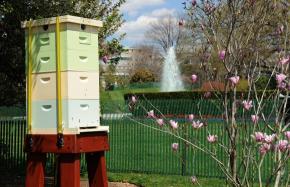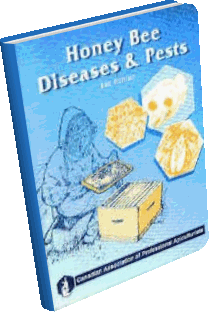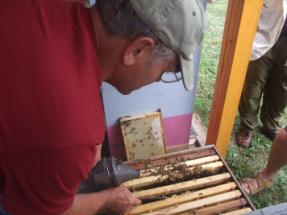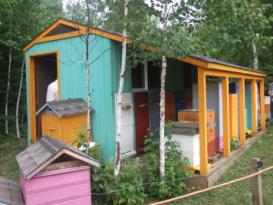Thunder Bay Beekeepers' Association Newsletter – September 2009

- First things first –
A BIG TBBA Shout-Out
to Rudy & Lois Kuchta and family for their hosting of the annual Summer Workshop - On Sunday afternoon, July 26 the TBBA members got a chance to see both hand-crafted wintering boxes & a well-designed wintering shed for Rudy's expanding apiary. Members got close-up & personal during hive examinations.
The Kuchta's Oliver Road rural homestead shows care & lots of hard work, with a substantial garden, chickens, geese and a beginning orchard. Everywhere the family's care shows in the details. The pot-luck was varied and imaginative. And let us remember, Beekeepers know desserts. Fab.!
Thanks, TBBA Executive - General Meeting
Tuesday , Sept 15th at 7 p.m. Stanley Hotel, Stanley - Highway 588 - Driving from Hgh 11/17 go to Stanley turn-off and approx. one kilometre by the Kam. River. (Early start 6:00 pm if you would like dinner - great burgers ! We appreciate their hospitality!)
Sept. Mtg Agenda:
1. Fall Feeding - The WHY & the HOW
2. Fall Re-Queening - It's different & Jeanette Momot will explain why.
3. Bee Inspector's Late-Summer Report & News
4. Other topics of interest - Wintering Basics (Joanne H. has a modified shallow super, fiber glass-filled, held in with plastic netting. A short piece of plastic weeping tile, positioned over the inner cover's hole, creates a permanent space for adding a jar of sugar syrup without disturbing the bees or needing to lift the super.
5. Potential Group Purchases - Should TBBA purchase a Hydrometer - ? - We could learn our honey harvest's moisture level without guessing!
6. TBBA Housekeeping - Election of a Vice-President. (You don't need to know a lot about beekeeping. It's more someone to share the planning of mtgs & association business.
7. Meeting Location: Looking for feedback from members if the 'Stanley' is working as a meeting location. The TBBA now has a lot of new members coming out and the back room at the Stanley can become crowded & difficult for all to hear. The Stanley is free, balanced with the TBBA having enough in the bank to rent space. Is there a better, central location for our mix of rural & urban membership? Suggestions –? - Hint
- In general - For honey harvest - Only remove honey frames having been 3/4 or more capped - minimum - This means that the honey has been evaporated / 'ripened' down to ~17% moisture. This is the natural level for long term storage for bees & human consumption. Yeasts cells are in suspended animation, unable to grow due to the super-saturated honey solution. (Late summer harvest you can push the 3/4 capping rule a bit, including some frames 1/2 capped. The general late summer weather & lower humidity tends to be drier & the honey is 'ripened'. The the bees just haven't had a chance to get to the capping.)
- Assoc. Meeting Schedule
- Meetings are on the first Tuesday of every other month. No meeting in January. July meeting is dedicated to a workshop.
- Queens
- Beekeepers who have late summer Queens to help fill the demand to re-Queen for the Fall with young, vigorous mated queens, if you haven't already - Please contact Valerie & Rob, our local Bee Inspectors.
- All the President's Bees

President Obama has a single hive installed at the White House's new organic garden. The hive stand, of 2x6s, bolted into a poured concrete slab, is elevated a meter & a half off the ground, the better to be away from the First Family's new dog. Two permanent, heavy -duty nylon tie-downs ensure the hive could withstand a hurricane. A local beekeeper is making the work, although he must check the hive balancing on a couple of planks & sawhorses. An early spring honey flow yielded 42 lbs of light, mild honey. Nectar flow slowed during June with an estimate of a further 80 lbs by the end of the summer.- Honey Plants: Buckwheat
- If you have some land...
 (Fagopyrum esculentum) Buckwheat is an ancient, short season crop that does well on low-fertility or acidic soils, but the soil must be well drained. Too much fertilizer, especially nitrogen, will reduce yields. The presence of pollinators greatly increases the yield of small, triangular hard seeds. The nectar from buckwheat flower makes a dark colored honey. Buckwheat is sometimes used as a green manure, as a plant for erosion control, or as wildlife cover and feed. Buckwheat was an important North American crop from about 1930 to the 1960s. (It is one of the most ancient food crops.)
(Fagopyrum esculentum) Buckwheat is an ancient, short season crop that does well on low-fertility or acidic soils, but the soil must be well drained. Too much fertilizer, especially nitrogen, will reduce yields. The presence of pollinators greatly increases the yield of small, triangular hard seeds. The nectar from buckwheat flower makes a dark colored honey. Buckwheat is sometimes used as a green manure, as a plant for erosion control, or as wildlife cover and feed. Buckwheat was an important North American crop from about 1930 to the 1960s. (It is one of the most ancient food crops.)
Buckwheat makes a dark coloured honey. Buckwheat is sometimes used as a green manure, as a plant for erosion control, or as wildlife cover and feed. Buckwheat was an important North American crop from about 1930 to the 1960s. A recent study has shown buckwheat honey to be more effective than over-the-counter cough syrup at treating childhood cough. It's colour is very dark amber.
(Hint: In general, dark honeys have more active health-promoting micro-ingredients that light honeys. New Zealand Manuka has a regular testing program with nutrition dense crops commanding off-the-scale prices.) - Bee Diseases: Nosema
Perhaps the Most Common Bee Disease (Thanks Wikipedia for some content.) - Until recently Nosema apis had been considered to be a single-celled
protozoan pathogen of the Western honey bee (Apis mellifera) . Nosema apis is a unicellular parasite of the class Microsporidia, which are now classified as fungi or fungi-related. Nosema apis has a resistant spore, which withstands temperature extremes and dehydration.
What's New: In 1996, a similar microsporidian parasite of the eastern honey bee (Apis cerana) was discovered in Asia, which was named Nosema ceranae. This form of Nosema has now crossed the species barrier and is spreading in North America.
(The eastern or Asian honey bee, Apis cerana, is found in Japan, China, India & surrounding countries. It is a bit smaller in size with prominent abdomen striping. There are less bees in their colony structure, Honey yields are not quite as high as the western honey bee, partly due to less intensive human breeding programs.)
Nosema symptoms are relatively non-specific, making confusion with other honeybee diseases possible. It arises mostly in the spring after periods of bad weather, although it may also be a winter disease that is only noticed in the spring when beekeepers first inspect their hives.
Nosema spores are spread to other colony members through fecal matter. The disease impairs the digestion of pollen thereby shortening the life of the bee. Young worker bee's housecleaning chores brings them into contact with the spores. The most notable symptom is dysentery, which exhibits itself through yellow/brown stripes on the outside of the hive and in severe cases, even inside the hive. Further symptoms include increased girth of the abdomen and missing sting reflex. Nosema, if left untreated, can cause queen supersedure, winter kills, reduced honey yields and dwindling populations. The seasonal trend of typical infections exhibits low levels during summer, a small peak in autumn, and a slow rise of infection during winter. In the spring the level of infection increases rapidly as brood rearing starts and while flight possibilities are still limited.
Colonies in Northwester Ontario are more seriously affected than colonies in the South because of our increased amount of time during the winter & spring the bees are confined in the hive.
Confirmed diagnosis is dependent on bee labs using 250x-500x microscopic examination of the ventricular content and/or fecal matter.
The standard treatment with the antibiotic Fumidil B (prepared from Aspergillus fumigatus, the causative agent of Stone Brood) inhibits the spores reproducing in the ventriculus, but does not kill the spores. A disinfection of the honeycombs and utensils is recommended for an extensive disease outbreak.
OMAFRA - Control measure:
As for every beekeeping procedure, there are mixed practices. Many established NWO beekeepers with hygienic bees and a good monitoring of colony health are not troubled by Nosema. Other local beekeepers use a Fall treatment of Fumidil B,(fumigillian), as a way of suppressing symptoms while over-wintering, as a precaution. Some will also use an additional, second Spring dose, before honey flow starts. Fumidil can be added to your regular Fall/Spring sugar syrup feeding or mixed with icing sugar and spread along the top bars, close to but not over the brood nest. (Avoid spilling down the frames, it will kill brood.)
This is a serious, readily transmissible disease.
(Bee Inspectors will recommend the best technique & mixing instructions at the Sept. meeting.)

To learn more,
order a copy of Honeybee Deseases and pests.
http://www.capabees.com/main/page.php?6 - Buying & Selling
- The following Beekeepers, offering to sell nucs and queens have Selling Permits - this means during 2008 our two local Bee Inspectors have visited their apiary checking for varroa & trachea mites. Clean!
(alphabetical ORDER )
Selling
- Randy Kushta 684-9028 2360 Oliver Road
- Jeanette Momot 939-1233 RR6 Highway 130
- Betty Ann Paradis 473-8202 RR1 Highway 608
- Bob Slusar 939-2995 181 - 22nd Side Road
- Curly Wojtalik 977-1090 RR1 Pass Lake
- TBBA T-Shirts
- Freshen up your wardrobe for the fall. Let friends, neighbours and even complete strangers know that you keep bees. Still a few bright yellow t-shirts with TBBA logo on the front & "worker bee" on the back. Reasonably priced 'at-cost' $15.
 Rudi & new nuc |
 Wintering shed & hives on wheels !! |